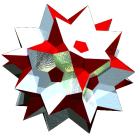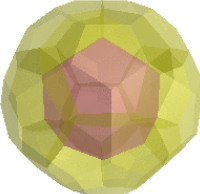©
xOo = xOx (II) |o
|x| = r
- surface equation
-
x12 + x22 = r2
- area
-
π r2
©
xOy
|x| = a1 < |y| = a2
- surface equation
-
x12/a12 + x22/a22 = 1
- area
-
π a1a2
| Site Map | Polytopes | Dynkin Diagrams | Vertex Figures, etc. | Incidence Matrices | Index |
Round shapes kind of fall out of a description by incidence matrices because several elements are missing there. E.g. a sphere has no edges at all. Also occur bended elements which thus sidestep from a hierarchical description. Therefore we are bound here more to a mere listing of individual shapes.
Mrs. W. Krieger invented a Dynkin type description applicable to severl of those. She uses the link symbol O for these round, i.e. circular elements. The first node of that corresponding component then has to be ringed as usual, resp. in the typewriter friendly linearized notation is given as x. Even so this cannot provide a true relative scaling factor, esp. when being combined with further (linear) edges additionally. On the other hand, within the round component itself, i.e. that Dynkin subsymbol, which uses O linkages only, one will have further node symbols also. There a subsequent o would represent a further dimension with the same curvature, while a node with any different measure y would represent a correspondingly different curvature. Thus xOo = xOx represents a (filled) circle, while xOy represents a (filled) ellipse.
In 2005 the operations of Cartesian product and spheration led to a different toratope notation. P. Wright, M. Čtrnáct, and W. Krieger in the sequel settled for an I representing each Cartesian dimension and a surrounding (...) for each spheration. Here each dimension I gets bounded by some maximal value, whereas in spherations (...) the squared sum of all contained entities (I or (...)) does. Thus a square is II, the circle is simply (II), a cylinder is (II)I, and a torus is ((II)I). As an argument to spheration sometimes larger cartesian products are needed. Those then are denoted by [...], e.g. II = [II], which here is redundant, but not so in ([II]I), which denotes then the crind.
In parallel to the former P. Pugeau and Quickfur developped their |,>,o devices. It always is to be read from the left, i.e. the rightmost operation is to be applied to the left "base". (This is why these symbols always start with a |.) The main constituents here are the extrusion |, acting like a prism operator, then the tapering >, acting like a pyramid/cone operator, and finally the spin o. – While the spin does rotate the body described by the left subsymbol around an internal axis, P. Pugeau later added a further (o) (manifold) in order to make the spin wrt. to an external axis. While (o) here describes an external circular move, (oo) an external spherical one, etc. And, just as above, the product [...] was added as well to a total STEMP (spin, tapering, extrude, manifold, product) notation.
Surface areas and volumes for rotational symmetric figures are easily derived by means of the Pappus centroid theorem. Which even allows for several extended applications too.
---- 2D (up) ----
| Image | Symbols | Name | Remarks |
|---|---|---|---|
|
xOo = xOx (II) |o | circle, circular disk |
|x| = r
|
|
xOy | ellipse, ellipse area |
|x| = a1 < |y| = a2
|
---- 3D (up) ----
|
Image / Links |
External links | Symbols | Name | Remarks |
|---|---|---|---|---|
|



|
xOoOo = xOxox (III) |oo | sphere, ball |
|
|


|
xOoOy = xOxOy |
prolate spheroid (like rugby football) |
|x| < |y| |
|


|
xOyOo = xOyOy |
oblate spheroid (like planets) |
|x| < |y| |
|
|


|
xOyOz | general ellipsoid |
|x| = r1 < |y| = r2 < |z| = r3
|
|



|
x xOo (II)I |o| = ||o | cylinder |
|
|



|
oxOoo&#x |o> = |>o | cone |
|
|



|
([II]I) | crind, Steinmetz solid |
intersection of x xOo with xOo x
|
|



|
((II)I) |o(o) | torus |
r < R
|
---- 4D (up) ----
|
Image / Links |
External links | Symbols | Name | Remarks |
|---|---|---|---|---|
|
|



|
xOoOoOo (IIII) |ooo | glome |
|
|
|



|
x xOoOo (III)I |oo| = |o|o = ||oo | spherinder |
prism (of length l) of a sphere (of radius r) sphere || sphere
|
|
|

|
oxOooOoo&#x |oo> = |o>o = |>oo |
sphone, spherone |
cone (of length h) of a sphere point || sphere
|
|

|
xx oxOoo&#x |o>| = |>o| | coninder |
prism (of length l) of a cone (of height h) cone || cone line || cylinder
|
|



|
x4o xOo (II)II |o|| = ||o| = |||o | cubinder |
duoprism of a square and a circular disk cylinder || cylinder
|
|
|

|
|o>(o) = |>o(o) | cone torus |
cone of height h and base radius r circling at radius R circle || torus r < R
|
|
|

|
|o>> = |>o> = |>>o | dicone |
cone-pyramid
|
|
|

|
|o|> = ||o> = ||>o | cylindrone |
cylinder-pyramid
H : cylindrical height h : pyramidal height
|
|
|


|
((II)I)I |o(o)| | torinder |
prism (of length l) of a torus torus || torus r < R
|
|



|
xOo xOo (II)(II) [|o][|o] | duocylinder |
limit of duoprism intersection of x4o xOo with xOo x4o
|
|
|


|
((III)I) |o(oo) | torisphere |
torus with a spherical crossection
r < R
|
|
|


|
((II)II) |oo(o) | spheritorus |
r < R
|
|
|

|
((II)(II)) | tiger |
r < Rk
|
|
|


|
(((II)I)I) |o(o)(o) | ditorus |
torus of a torus crossection
ρ < r < R
|
© 2004-2025 | top of page |